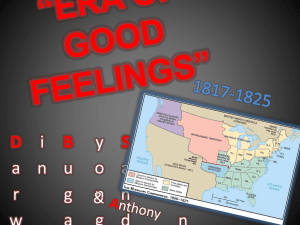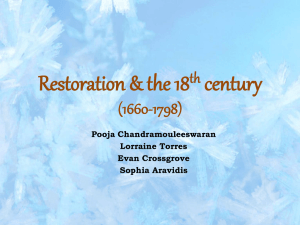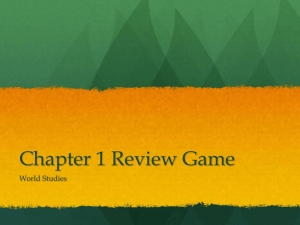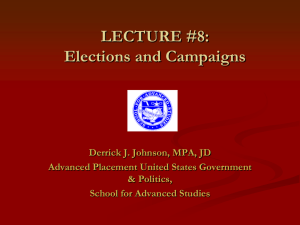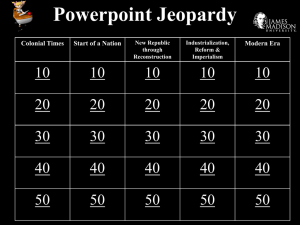GeoHistogram Activities
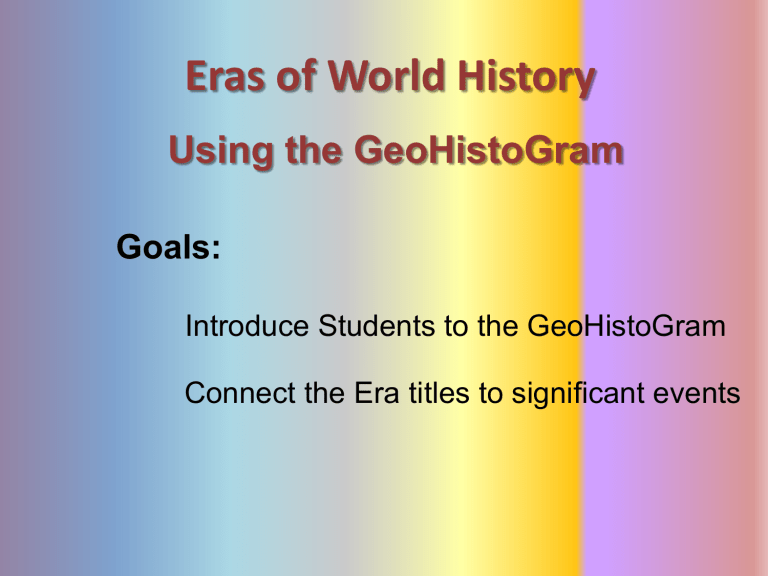
Eras of World History
Using the GeoHistoGram
Goals:
Introduce Students to the GeoHistoGram
Connect the Era titles to significant events
Eras of World History
Using the GeoHistoGram
The history of the world has been divided into eras to help organize the information.
Each of the eras has been named to help define the events during that time.
We will use the GeoHistoGram to look at both the dates and the areas to get a basic understanding of the history of our world.
The GeoHistoGram
The GeoHistoGram shows both time (chronology) and place (region)
The GeoHistoGram
This is the basic form of the GeoHistoGram – seven vertical bars.
The GeoHistoGram from the distant past on the bottom to the present at the top.
represents 1000 years of history in that region.
The GeoHistoGram
Here is a simple use of the GeoHistoGram: to show ancient empires in Mesopotamia.
(before the Common Era, and roughly in the middle of the world’s land).
The GeoHistoGram
By varying the width of the empire “blob”, you can show how its power expanded at different times.
Adding a shape in northeast Africa can show how Egypt lasted a long time but varied in importance.
The GeoHistoGram
Some words you need to know:
Era: a period of time Migration: the act or process of moving from one region or country to another
Pastoral: herding or keeping animals for food, transportation, etc.
Agriculture: farming; cultivating the land, producing crops, and raising livestock
Civilization: a highly developed society: with a high level of culture and social organization
Empire: lands, a group of nations, territories, or people ruled by a single authority.
Colonization: to establish a colony in another country or place
Revolution: a dramatic change in ideas or practice
Imperialism: the policy of extending the rule or influence of a country over other countries or colonies
Nationalism: excessive devotion to a nation and its interests, often associated with a belief that one country is superior to all others
GeoHistoGram Activities
Mark the Eras on the Geohistogram
The first era is “Beginnings of Human
Society ” (Beginning to 4,000 BCE)
The “Beginning” was about 200,000 years ago!
The first humans migrated out of Africa and had populated most areas of the world by
10,000 BCE
Why do you think humans migrated out of Africa?
How did people survive?
By the end of this era, humans had learned to herd animals and plant crops. This was a major lifestyle change and led to permanent settlements.
Era 1:
Beginnings of Human Society
Pre-history - Homo sapiens spread across the world
GeoHistogram Activities
Mark the Eras on the Geohistogram
The second era is “Early civilizations and
Cultures and the Emergence of Pastoral
People ” (4000 – 1000 BCE)
What is a “civilization”?
What are “pastoral people”?
Era 1: Beginnings of Human Society
What does Pastoral mean?
The first settlements occurred in areas where agriculture was possible, namely river valleys.
What rivers were located in these areas?
The Fertile
Crescent
Egypt
India
China
Tigris and
Euphrates
Nile
Indus
Huang He
Era 2:
Early Civilizations and
Emergence of Pastoral Peoples
Era 1: Beginnings of Human Society
Having a stable food supply allowed some people in the settlements to have other jobs.
This division of labor led to the development of civilizations.
Some elements of civilization include the development of cities art specialized jobs religion communication laws
Era 2:
Early Civilizations and
Emergence of Pastoral Peoples
Era 1: Beginnings of Human Society
These are the names of the civilizations that began during this era in these regions:
Africa
Middle East
Central Asia
East Asia
The size of the colored shapes show the growth and extent of each one.
Which one did not continue to grow into the next era?
Era 2:
Early Civilizations and
Emergence of Pastoral Peoples
GeoHistogram Activities
Mark the Eras on the Geohistogram
The third era is “Classical Traditions,
World Religions, and Major Empires ”
(1000 BCE to 300 CE)
What are the major “classical” civilizations?
What “world religions” were predominant?
What “major empires” developed?
Era 2: Early Civilizations and
Emergence of Pastoral Peoples
Era 1: Beginnings of Human Society
With the rise of civilizations and development of new technology, trade helped spread ideas.
In East Asia, the Qin Dynasty united a territory which is now ___ ??
____, the most populous country in the world.
Growing civilizations, needing more land and resources, used force to expand, and became empires.
Era 3:
Classical Traditions and Major Empires
These are the two large (classical)
European empires that characterize this era.
What famous Greek leader conquered Egypt and advanced into Central Asia?
Era 2: Early Civilizations and
Emergence of Pastoral Peoples
Era 1: Beginnings of Human Society
Empires grew by conquering people of many cultures. World Religions, like Buddhism and Hinduism, also spread.
Other large empires ruled during this era. Where are each of them located?
Persia?
Mauryan?
Middle East
India
Han Asia
Era 3:
Classical Traditions and Major Empires
What was the first civilization in the Western Hemisphere?
GeoHistoGram Activities
Mark the Eras on the Geohistogram
The fourth era is “Expanding and
Intensified Hemispheric Interactions ”
(300-1500 CE)
What do “expanding” and “intensifying” mean?
What “hemispheric interactions” took place?
Era 3: Classical Traditions and Major Empires
Era 2: Early Civilizations and
Emergence of Pastoral Peoples
Era 1: Beginnings of Human Society
Empires expanded during this era:
The eastern Roman Empire became the Byzantine Empire, but had many enemies. What does its shape tell you?
By about 700 CE, what dynasty in
Asia had expanded westward?
Era 4:
Expanding Hemispheric Interactions
Islam spread by both trade routes and conquering armies into north Africa and central Asia.
What was the major trade route connecting China to Europe?
Mongols conquered both Chinese and
Muslim empires and spread into
Europe.
Era 3: Classical Traditions and Major Empires
Era 2: Early Civilizations and
Emergence of Pastoral Peoples
Era 1: Beginnings of Human Society
Empires expanded during this era:
In West Africa, what two empires became wealthy through trade?
The Plague spread across Europe killing a quarter of the population.
How is this shown on the GeoHistoGram?
Era 4:
Expanding Hemispheric Interactions
Marco Polo sparked a new interest in trade with China.
What effect did the demand for products from Asia have on Europeans?
See Era 5!
GeoHistoGram Activities
Mark the Eras on the Geohistogram
The fifth era is “Emergence of the First
Global Age ” (15 th to 18 th Centuries)
What is a “global age”?
Era 4: Expanding Hemispheric Interactions
Era 3: Classical Traditions and Major Empires
Era 2: Early Civilizations and
Emergence of Pastoral Peoples
Era 1: Beginnings of Human Society
What important event marks the beginning of this era?
Era 5:
Emergence of 1 st Global Age
The ability to navigate the ocean caused many changes in trade and power.
Columbia Exchange was an important trading system between the Eastern and Western Hemispheres.
What 3 regions were involved?
What was exchanged?
European Colonialism starts in this era.
What color shows its spread?
Which direction did it spread?
What other Empire expanded its power during this era?
GeoHistoGram Activities
Mark the Eras on the Geohistogram
The sixth era is “Global Revolutions” (Late
1700’s through 1914)
What is a “global revolution”?
Era 5: Emergence of 1 st Global Age
Era 4: Expanding Hemispheric Interactions
Era 3: Classical Traditions and Major Empires
Era 2: Early Civilizations and
Emergence of Pastoral Peoples
Era 1: Beginnings of Human Society
Era 6:
Age of Global Revolutions
Explain the saying “The Sun never sets on the British Empire”
During this era, revolutions freed many colonies from their European conquerors or feudal leaders.
American
French
Latin American
Chinese Russian
As the Ottoman Empire declined,
Europe’s power increased.
Many changes occurred including an increase in world migration and industrialization. Nationalism and imperialism grew in Europe, Asia, and America.
GeoHistoGram Activities
Mark the Eras on the Geohistogram
The seventh era is “Global Crisis and
Achievement ” (1900-1945)
What is a “global age”?
Era 6: Age of Global Revolutions
Era 5: Emergence of 1 st Global Age
Era 4: Expanding Hemispheric Interactions
Era 3: Classical Traditions and Major Empires
Era 2: Early Civilizations and
Emergence of Pastoral Peoples
Era 1: Beginnings of Human Society
Era 7:
Global Crisis and Achievement
Increasing government, economic and political power changed the global balance of power.
Two World Wars occurred as well as mass genocide in several regions.
What major event ended WW II?
Important advances were made in technology, medicine and communications during this era.
What countries emerged as super-powers?
GeoHistoGram Activities
Mark the Eras on the Geohistogram
The eighth era is “The Cold War and Its
Aftermath: The 20 th Century since 1945”
What was the “Cold War”?
Era 7: Global Crisis and Achievement
Era 6: Age of Global Revolutions
Era 5: Emergence of 1 st Global Age
Era 4: Expanding Hemispheric Interactions
Era 3: Classical Traditions and Major Empires
Era 2: Early Civilizations and
Emergence of Pastoral Peoples
Era 1: Beginnings of Human Society
Era 8:
Cold War and Aftermath
The Cold War was a conflict between democracy and communism.
What two countries were the leaders in this “war”?
Some “hot spots” caused mounting tension, and conflicts in Korea and
Vietnam became major clashes.
One of the fears that surfaced was the threat of nuclear war.
What event signified the end of the “Cold War”?
GeoHistoGram Activities
What might the next era be called? How long will it last?

